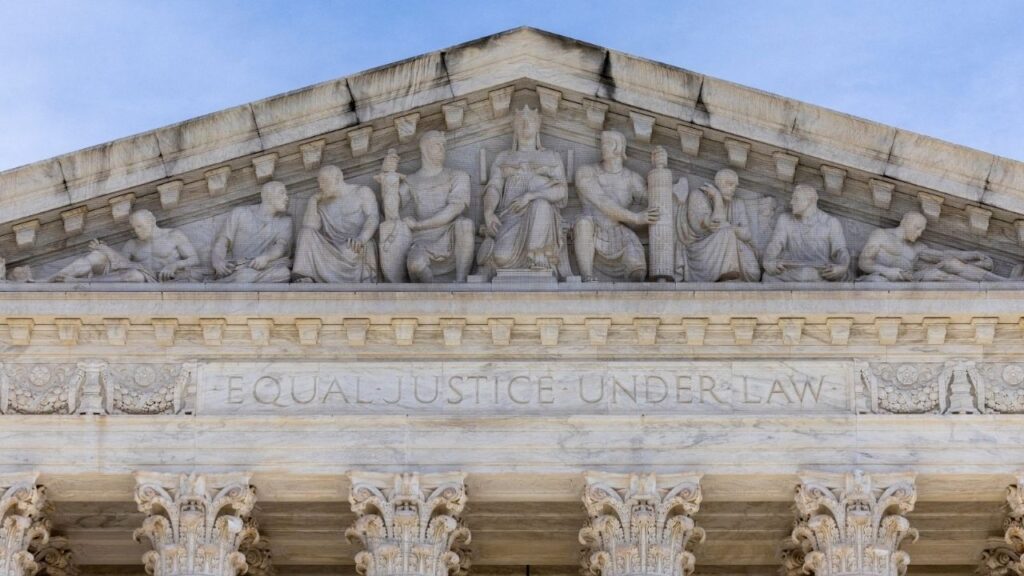Former President Donald Trump, the Republican presidential nominee, and former first lady Melania Trump on stage during a campaign rally at Madison Square Garden in New York, Oct. 27, 2024. As the presidential contest enters the final sprint, campaign aides and allies close to Vice President Kamala Harris are growing cautiously optimistic about her chances of victory, saying the race is shifting in her favor. (Kenny Holston/The New York Times)

- National polls show Vice President Harris leading Trump by less than 1 point, her smallest margin since mid-August.
- Despite a diminishing national lead, Harris stays competitive in key battleground states, maintaining close races.
- Analysts speculate whether concentrated battleground campaigning or potential polling inaccuracies might decide this closely contested race.
Share
|
Getting your Trinity Audio player ready...
|
With one week to go until the election, Vice President Kamala Harris’ lead over former President Donald Trump in the national polls is starting to get very slim.
Overall, she leads by less than 1 percentage point, according to The New York Times’ polling average. It’s her smallest lead since mid-August.
Even so, last week’s polls did offer a silver lining for her: The state polls didn’t seem to lurch toward Trump, even as the national polling did.
The battleground states remain extraordinarily tight, with no candidate holding any material lead in the seven states likeliest to decide the presidency. In a sense, that’s not surprising. What’s interesting is that Harris remains competitive in the battlegrounds even though her national lead has dwindled.
Related Story: Election 2024 Latest: Trump and Harris Enter the Final Stretch of the 2024 ...
Usually, a tied national vote would not augur well for Democrats. In his first two races, Trump did much better in the battleground states than nationally, allowing him to defeat Hillary Clinton without winning the national popular vote and almost doing the same against Joe Biden.
In 2020, he lost the national popular vote by 4.5 points, but he lost the core seven battleground states by an average of only 0.9 points — a difference of more than 3 points.
In the current polling averages, the gap between the national polls and the battleground average has fallen beneath 1 point.
The possibility that Trump’s Electoral College advantage might fade a bit this November isn’t necessarily a surprise. Over the last few years, there have been a lot of signs of it, from the midterm results to the demographic patterns in national polls.
Still, these theories don’t necessarily explain why the polls have appeared to trend in different directions over the last few weeks.
Related Story: Puerto Ricans React With Fury to Comedian’s Insult at Trump Rally
Two Polling Stories
There were nine national surveys from “select pollsters” (which means they meet certain criteria for reliability) released this past week, and they couldn’t have shown a closer race. Three showed a tie, including the Times/Siena College poll, and three showed Harris ahead. Her best, an ABC News/Ipsos survey, found her up by 4 points.
On the other hand, three of the polls showed Trump ahead — his best, the Wall Street Journal poll, found him up by 3 points.
If you just take the simple average of those nine polls, you find Harris ahead by less than a point. The math behind the Times polling average is fancier than that, but it gives you the same answer.
In nearly every case, the national polls this past week showed Trump gaining compared with the last survey by the same firm.
In state polling, meanwhile, Marist showed a close race in Georgia, North Carolina and Arizona — ranging from a tied race in Georgia to a 2-point Trump lead in North Carolina. In each of the three, the polls were close to the Times average and similar to the prior Marist polls of the same states.
The latest polls in the Northern battlegrounds stayed close as well. Quinnipiac found the race tied in Wisconsin, with Harris ahead by 4 points in Michigan. Importantly, the two results were quite a bit better for her than the last Quinnipiac poll, which showed Trump ahead in both states.
Related Story: New ‘RBG PAC’ Spending $19 Million From Secret Donors to Aid Trump on ...
Why Has Harris Stayed Resilient in the Battlegrounds?
One possibility is that she hasn’t. There were a lot of high-quality national polls last week from many different pollsters, but there weren’t many state polls — and most of the state polls came from just two firms. We expect many pollsters’ final state polls over the final stretch; perhaps they will belatedly show a shift toward Trump.
Another possibility is that her resilience is the result of the intense campaign in the battlegrounds. Millions of dollars are being spent on advertisements there as the candidates barnstorm this small group of states. The rest of the country is not experiencing this barrage, and it’s possible that has contributed to the relative stability of the race there.
There’s a final possibility: One set of polls — the national polls or the state polls — could simply be more accurate than the other. Maybe Harris will ultimately win by a fairly comfortable margin nationwide, or, alternately, Trump could win easily in the battlegrounds. It certainly wouldn’t be the first time that the battleground state polls underestimated Trump.
Related Story: Election 2024 Latest: Trump and Harris Enter the Final Stretch of the 2024 ...
What if the Polls Are Wrong?
There is precedent for the state and national polls to err in different directions.
In 2012, the national polls underestimated Barack Obama, but were right about his clear lead in Ohio — and therefore in the Electoral College.
The story was flipped around in 2016 and in the 2022 midterms. In those two elections, the national polls were pretty good, while the core battleground state polls were off. And interestingly, they were off in different directions: In 2016, the battleground state polls badly underestimated Trump, while the polls of key states for Senate races underestimated Democrats in 2022.
If the polls err as they did in 2020 or 2022, the outcome could look completely different.
With the race so close, it wouldn’t even take anything like a 2020 or 2022 polling error to yield a different outcome. After all, six of the battleground states are within a point. The polls are never exactly right; if they err one way or another by a point or two, as usual, then one side could win by a decisive margin.
–
This article originally appeared in The New York Times.
By Nate Cohn/Kenny Holston
c. 2024 The New York Times Company
RELATED TOPICS:
Categories

US Supreme Court Turns Away Appeal of Texas Library Book Ban


















